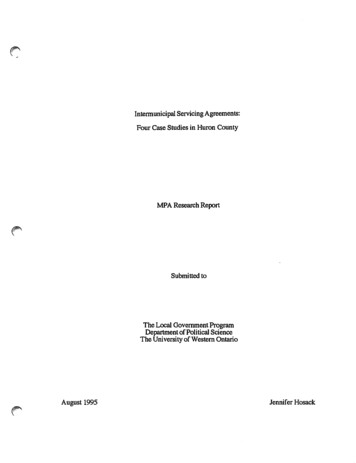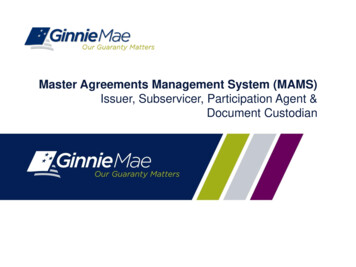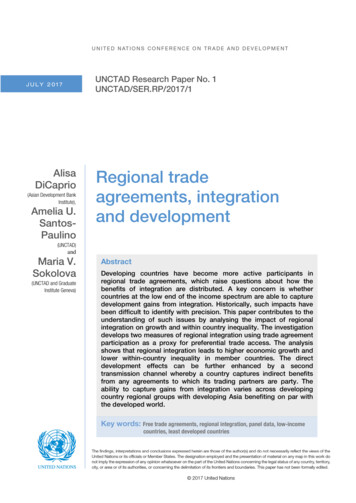
Transcription
Intermunicipal Servicing Agreements:Four Case Studies in Huron CountyMPA Research ReportSubmitted toThe Local Government ProgramDepartment of Political ScienceThe University of Western OntarioAugust 1995Jennifer Hosack
TABLE OF CONTENTSPage No.LIST OF FIGURES, MAPS AND TABLESCHAPTER 1CHAPTER 2INTRODUCTIONBackground of the IssueResearch Plan157LITERATURE REVIEWHistory of Intergovernmental AgreementsPurpose of Intergovernmental AgreementsExamples of Intergovernmental Agreements991014RESEARCHBackground Information on Huron CountyBrief Description of the Four Case Study Servicing2222Critical Factors in the Research32ANALYSISIntroductionInitiation of the AgreementAccountability and ResponsibilityBenefits of the Agreement4444444647Administering the AgreementBenefits of Intergovernmental AgreementsDisadvantages of Intergovernmental AgreementsCHAPTER 3AgreementsCHAPTER 4Keys to SuccessDisadvantages of the AgreementCouncils'Involvement in the AgreementAdministering the AgreementThe Use of Servicing Agreements versus a Regional AuthorityCHAPTER 51619202350 5154'.'.'.'.'.'. 5557Patterns of Cooperation60CONCLUSION63BIBLIOGRAPHY66
LIST OF FIGURES, MAPS AND TABLESPage No.LIST OF FIGURESFigure 2.1: Horizontal Pattern of AgreementsFigure 2.2: Vertical Pattern of Agreements1313LIST OF MAPSMap 1.1: County of HuronMap 3.1: Town of Exeter and Surrounding AreaMap 3.2: The Village of Grand Bend and Surrounding AreaMap 3.3: The Town of Goderich and Surrounding Area3242730LIST OF TABLESTable 2.1: Benefits of Municipal Agreements Between LocalGovernment UnitsTable 2.2: Keys to Success When Developing Municipal Agreements1920
Chapter 1INTRODUCTIONIn order for a municipality to provide services, there are several options availablefor it to choose from. One alternative may be intergovernmental agreements whereby oneor more municipalities provide the service and one or more municipalities purchase it. Anintergovernmental service contract is an arrangement between two governmental units inwhich one pays the other for the delivery of a particular service to the inhabitants in thejurisdiction of the paying government (ACIR c, 1985, p. 1). Such contracts may be formal(written) or informal (unwritten). Another similar contract is a joint service agreement,where an agreement occurs between two or more governments for the joint planning,financing, and delivery of a service to the inhabitants of all jurisdictions participating in theagreement (ACIR c, 1985, p. 2).These types of agreements are a flexible alternative for municipalities that are eitherproducing or purchasing a service. Furthermore, these agreements can be administereddirectly by the municipalities or by a mutually appointed agency. Although servicingarrangements have been previously used by municipalities, they are becoming increasinglymore innovative. There are several applications of sharing municipal services that can befound in Ontario. A partial listing would show:landfill sitesspecial road equipmentby-law enforcement officerswater billingwaterworkspolicingbuilding inspectorsdog poundsplanning stafffire protection(MMAH, 1983, p. 4)
2Four case studies will be examined to demonstrate how intergovernmental servicingarrangements for sewage and water services are important and deal effectively withpractical problems faced by local governments. The four case studies involve small towns,villages and townships within the County of Huron, which is located in southwesternOntario. See Map 1.1 for a map of Huron County. Two of the case studies deal withtypical servicing agreements. These involve the arrangement of service delivery for thesupply of water and the expansion of sewage treatment facilities to service a larger area thatcrosses political boundaries. The third case study deals with a town that is the producer ofwater and sewage services which sells its services to a developer in an abuttingmunicipality. The fourth case study looks at a potential joint servicing arrangement forsewage services among three municipalities. This is an innovative approach to deal withsewage treatment facility problems in three municipalities. Together these four case studieswill show: 1) how the agreements were initiated; 2) the advantages and disadvantages ofagreements; 3) the keys to success; 4) responsibility and accountability issues; and 5) howthey are administered.The administration of the agreements is one of the primary areas I will be focusingupon. Most provincial-municipal relations involve the municipality with some agency ofthe Ontario government. It is becoming apparent that no one level of government canoperate effectively in isolation. The public issues requiring resolution today usually call forthe combined efforts of two or more levels of government (Tindal, 1988, p. 105). Thegeneral trend over time has been in the direction of increasing provincial supervision andcontrol of local government (Tindal, 1988, p. 108). This has occurred in response to theserious problems and pressures facing local government.
Map 1.1:Countv of HuronTURNBERRYWinghamBayfieldSTANLEYGrand Bend\TUCKERSM17H
Two of the service agreements that I will be examining are administered by theOntario Clean Water Agency (OCWA). The OCWA operates as an independent agency forthe purpose of administering such service contracts for municipalities. Essentially, theagreement is between the municipalities and the OCWA. The service contract wouldoutline the OCWA's responsibility as well as the municipality's. The top-rated strategiesfor innovation tend to be those that allow policy-makers to retain their flexibility and sustaintheir legitimacy for future decision situations (Clarke, ed., 1989, p. 27). One of theobjectives of using the case studies is to demonstrate that local municipalities becomingpartners with OWCA provides the administration and council with the most flexibility forany changes in the agreements.The OCWA is a Crown corporation in business to provide services related to waterand wastewater treatment (OCWA c). It currently operates 367 water and wastewatertreatment facilities for municipal clients throughout Ontario. Furthermore, the agencyoffers technical advice and assistance, capital financing and project management services.The agency can assist municipalities in every step of the process. It can manageconstruction projects and plant upgrades throughout the entire project to ensure the needs ofclient municipalities are met during the design, tendering and construction phases (OCWAb). Once the plant is constructed, the OCWA can provide a municipality with a full rangeof operating and maintenance services.In addition to the operations and maintenance services and project managementservices, the OCWA actively promotes water conservation. Because it is in the water andwastewater business, it concentrates on improving the efficiency of water treatment,distribution and use (OCWA c). As a result, it helps communities save money by loweringoperating costs and reducing capital expenditures for water and wastewater systems.
5The OCWA also lends money to municipalities and facilitates private sectorinvestment in municipal water and wastewater projects (OCWA c). The reason it canafford to lend municipalities money results from a revenue base of more than 200 millionand assets totaling more than 600 million (OCWA b). Moreover, the agency investsdirectly in new and existing projects in Ontario. Through the use of the Ontario FinancingAuthority, the OCWA can arrange for loans for a municipality's portion of its capital costs(OCWA a, 1994, p. 2). The agency will also assist the municipality by helping to developcost-sharing partnerships with the private sector and other sources of money.When municipalities are embarking on a major water or wastewater project, theOCWA can assist the municipality in every stage including the financing of it. This isimportant because many municipalities do not have the funds available to finance thesetypes of capital projects. The OCWA becomes a partner with the municipality that has the/psvexpertise, experience and funds to aid municipalities. This partnership can be verybeneficial to municipalities who do not have the experience or expertise dealing with alarge-scale project.Background of the IssueIn the past, allocations from upper levels of government led to dependence onintergovernmental funds or transfer payments. Therefore, local municipalities were placedin a difficult position because they required large sums of grants/transfers. But now theprovincial government is cutting these payments. The result is developing innovativesolutions or increased dependence for local municipalities (Clarke, ed., 1989, p. 41). As aresult, municipalities are turning to innovative solutions such as intergovernmentalagreements.
Some of the wastewater treatment plants are inadequately maintained and thesefacilities need immediate attention. There has also been a migration of people to thesuburbs as well as the countryside. This means an increase in demand for facilities incommunities that may or may not have municipal water or sewage treatment plants (ACIRb, 1984, p. 6). These facilities may be too small or overly distant from other plantscausing users to rely on facilities that are outworn or otherwise inefficient. Municipalitiesmay have neglected maintaining existing facilities causing them to be inadequate (ACIR b,1984, p. 8). The physical infrastructure may be inadequate to serve the economic needs ofcommunities, perhaps reducing a municipality's competitiveness for future development.For example, if a sewage treatment plant was at capacity, it may affect the municipality'stax base because no new development would be permitted until the facility was improved.Municipalities may choose to postpone or prevent new construction or repairs of facilitiesbecause it may have selected to finance other projects. This only leads to inefficient andoutdated facilities (ACIR b, 1984, p. 9).Many of the treatment facilities are becoming increasingly inadequate. They areaging and deteriorating with some water and sewage systems being over 100 years old. Itis estimated that 10 billion is required to improve the treatment facilities in Canada(Meakin, 1993, p. 11). The reason why this is occurring relates to the fact that Canadiansare not paying the true cost of their water. As a result, more realistic pricing is needed.Intergovernmental agreements may help to improve existing facilities or construct newones. Without municipalities sharing services or the construction of facilities, existingplants will continue to deteriorate. In addition, intergovernmental agreements may alsohelp Canadians pay for the true cost of their water because the water or sewage ratesestablished for residents are based on usage. As a result, residents pay for what they useand the municipality pays an annual fee to account for leakage in the water system. The
7sewage rate is based on the consumption of water, so residents are again paying for the truecost of their water and sewage services.Research PlanInformation gathered in this research project is based on the applicable documentsfrom provincial agencies and municipalities and from interviewing the relevant peopleassociated with the servicing agreements. A total of seven people were interviewed. Mostof the clerks of the municipalities were interviewed as well as engineers, a commissioner ofworks and a manager of a public utilities commission.The literature review in chapter two looks at the history and purpose ofintergovernmental agreements. There are three examples of these agreements examined,demonstrating the diversity and extent of servicing agreements. Furthermore, attention hasbeen given to how agreements are administered as well as the benefits and disadvantages ofservicing agreements.Chapter three examines the research conducted from the four case studies. There isa brief description of each of the four servicing agreements. In addition, the critical factorsof the research will be presented by the following headings: 1) initiation of the agreement;2) accountability and responsibility; 3) benefits of the agreement; 4) keys to success; 5)disadvantages of the agreement; 6) council's involvement in the agreement; and 7)administering the agreement.In chapter four, the major elements of the research will be discussed. The sameheadings used in chapter three to present the research will be used again in order to analyzethe research findings. In addition, the use of agreements versus the use of a regional
8authority will be analyzed. The patterns of cooperation based on the population size ofmunicipalities will also be discussed.Chapter five, the conclusion, summarizes the main points of the essay.
Chapter 2LITERATURE REVIEWHistory of Intergovernmental AgreementsFor many years, local governments have entered into agreements for the provisionof services. They can be regarded as an adaptive procedural response to problems becausethe local government does not have to reorganize its political boundaries. Many of theseagreements in the United States date back to the mid-1800's. A government may contractwith another government unit for the provision of certain services. For example, amunicipality purchases water and sewage treatment from a sanitary district or a townshippurchases police services from a county (Ruchelman, 1989, p. 5). These agreements haveremained popular because a government can obtain a service in which it cannot produceitself or cannot afford.Governments enter into intergovernmental service arrangements because theyfacilitate specialization and economies of scale that can result in reduced costs and improvedservice quality (Ruchelman, 1989, p. 25). Furthermore, they are also politically feasiblebecause the basic structure of the local government system does not have to be changed.The agreements do not restrict freedom of action or local autonomy, do not require voterapproval, and can be executed with little notice. Therefore, they are a flexible tool for localpoliticians and administrators to put into practice (ACIR d, 1974, p. 30).
10A joint municipal initiative is the sharing among two or more municipal bodies ofthe delivery, administration, or financing of a service under municipal jurisdiction. It is anarrangement by a municipality with another council or local government body to carry outthe function or service at joint expense and for joint benefit. Depending on its type, a jointservice is authorized by the Municipal Act or by other acts governing municipalities(MMAH, 1983, p. 1). Of the 2069 American cities and counties that were surveyed by theAdvisory Commission on Intergovernmental Relations in 1985,52% have service contracts(ACIR, 1985 c, p. 25). This statistic demonstrates how common service agreements are.Purpose of Intergovernmental AgreementsIntergovernmental agreements can be used to undertake jointly any functions andresponsibilities which governments could undertake singly, and contracts can similarly bej»vused to purchase any services or facilities which one government is authorized to undertakeor to provide on its own authority (ACIR a, 1967, p. 2). Agreements or contracts whichestablish administrative agencies are alternatives to other approaches which could be taken.Special districts or agencies, for example, might be established under statutory provisionsby resolution of local governments or by referendum among voters in the areas to beserved. The agreement or contract approach permits greater flexibility and local adaptationto meet particular problems (ACIR a, 1967, p. 3).An alternative to standard service delivery that authors Osborne and Gaebler regardas innovative includes public-public partnerships (Osborne, 1992, p. 31). Governmentsshould turn towards steering rather than rowing. This means that the government shouldthe arranger (steering) rather than the producer (rowing) of the service. It should setpolicy, deliver funds and evaluate performance (Osborne, 1992, p. 40). When contractingf a service to another governmental unit, it can be difficult because writing and monitoring
11contracts require so much skill. To contract out appropriately, Osbome and Gaeblersuggest creating a position to deal with the administrative details of the contract. Thisposition would be a contract monitor who would possess the skills to administer thecontract (Osborne, 1992, p. 87). Another alternative is to contract to an agency that alreadyhas the expertise and required experience. This would reduce some of the municipality'swork because a new person would not have to be hired and trained to administer thecontract.Although cooperative arrangements vary, the most commonly used method is theintergovernmental contract whereby one jurisdiction is paid to produce the service whileanother neighbouring jurisdiction retains policy and financial control. The major use ofservice contracts occurs when a relatively small unit purchases a public good or servicefrom a larger unit. This occurs because the larger unit has lower costs of production and/SPNcan sell to the smaller unit at a lower price than it would cost the smaller unit to produce theservice for itself. At the same time, the smaller unit is able to specify the quantity or qualityof the service to be provided, and thus citizen preferences are met more closely than wouldbe the case if the small unit were simply merged with the larger unit (Bish, 1973, p. 59).The situation would also apply whereby a number of small municipalities without alarge tax base share in the expense of establishing a sewage treatment plant or purchase theservice from a larger adjacent municipality. Service areas where cooperative agreementsare most common include waste disposal, public safety, health care, transportation, publicworks, recreation, and risk management (Ruchelman, 1989, p. 26).
12Intergovernmental agreements are used for the following reasons:to meet an urgent problemcitizens demand for a service agreementmost efficient use of staff(ACIR c, 1985, p. 35)Joint municipal initiatives can help a municipality to replace an obsolete facility and cut backon operating costs. Service levels can be maintained and the strain can be reduced ofproviding for users who cross municipal boundaries. There are also opportunities that canbe achieved by having a municipal agreement. Price discounts by pooling on purchaserequirements and the development of an expert computer staff are only two examples of theopportunities that can be achieved (MMAH, 1983, p. 3).The tendency to enter into agreements is related directly to population size, largerunits of government appear to have a greater propensity to enter into service agreementsthan smaller units. Smaller municipalities (less than 10 000 population) usually receiveservices under agreements with other units comparable in size compared to largermunicipalities (greater than 25 000 population) (ACIR d, 1974, p. 35). Local governmentsmost commonly enter into agreements with counties (60%) and other municipalities at40%. This was part of a survey conducted in the United States in 1973 of approximately2300 incorporated municipalities with a population greater than 2500 population. Mostagreements based on the survey results are for one service rather than a package ofservices. A package of services may include emergency, library, planning and streetmaintenance (ACIR d, 1974, p. 35).There are also patterns of cooperation that emerge where considerable use is madeof intergovernmental contracts and agreements. The "horizontal" pattern is based onagreements among similar governments for mutual undertakings. For example, towns andvillages may establish joint police forces or agree to share a sanitary landfill operation. A
13"vertical" network of agreements develops between larger units such as cities, counties orthe province and smaller municipalities. For example, a county will take the initiative ininforming local governments of the availability of the services and in facilitating theirentering into contracts for the use of them. Similarly, a "vertical" pattern occurs when acentral city provides services to surrounding towns, villages and suburbs. The verticalrelationship is more common since major jurisdictions have the facilities and the trainedpersonnel which smaller jurisdictions need (ACIR a, 1967, p. 13).Figure 2.1:Horizontal Pattern of AgreementsExample of a sanitary landfill operation:Town population: 25 000Village 550/0Figure 2.2:Vertical Pattern of AgreementsExample of a sanitary landfill operation:City300 000Town50 000Town65000 Town15 000
14Examples of Intergovernmental AgreementsThe fiscal strategies that U.S. cities are using today reflect how innovative citieshave had to become. As municipalities search for alternatives to taxes, user fees were themost popular strategy employed, but approximately 45.6% of U.S. cities surveyed haveused joint purchasing agreements (Clarke, ed., 1989, p. 45). This is an indication thatCanadian municipalities are probably using similar types of agreements in order to dealwith fiscal strain. Most American cities are not cutting back substantially on their functionsor work forces; instead, they are looking for cheaper ways or alternative funding to dowhat they already do. The most popular strategies seem to be the least threatening toestablished bureaucratic interests and offer tangible benefits to some staff (Clarke, ed.,1989, p. 58). Intergovernmental agreements provide municipalities with a flexiblealternative that are not threatening to established bureaucratic interests.A case study was carried out in the Tyneside/Wearside area of England for theexamination of twenty-one local governments that were facing capacity problems of theirlandfill sites (Pinkus, 1981, p. 161). A steering committee recommended thatmunicipalities share in the cost of constructing refuse treatment plants (Pinkus, 1981, p.162). This proved to be the most economical arrangement for the governments in this area.Cooperation among the municipalities would generate a savings of ten percent for eachlocal government than if each continued to dispose of refuse individually (Pinkus, 1981, p.163). When the steering committee was recommending the type of refuse facility, itdetermined that the more expensive alternative was appropriate, because it would have theleast impact on the quality of life for the residents (Pinkus, 1981, p. 188). Therefore,using the quality of life as the main criterion, the steering committee was able to suggest amore economical solution to the local governments, meanwhile, ensure that the quality oflife for the residents was not adversely impacted. This one case study demonstrates how
15governments can work cooperatively to save money and to provide the best quality of lifefor the residents. By municipalities sharing the expense of water and sewage treatment, acost savings is generated and the quality of life for residents living in the immediate area ofthe facilities is improved.In Pensacola, USA, its sewage treatment facility was operating at 50% capacity andthe cost of maintaining it as well as the original capital expenditure was too expensive forthe city to endure (Moore, ed., 1983, p. 171). In order for the city to deal with theoperating expenses, it dropped the advanced wastewater treatment facility classificationwith the environmental protection agency (EPA). As a result, the cost of plant operationswas significantly reduced and the capacity could be increased. Meanwhile, the county inwhich Pensacola is located was facing EPA demands to upgrade its existing treatmentplants and build new plants to meet growth demand in certain areas. Both governmentsagreed to the establishment of an independent, county-wide utility authority to administerthe sewage and water systems. The city and county transferred its water and sewagesystems to the authority. This helped to alleviate the need for the county to build additionalfacilities and the city's facility could utilize its additional capacity (Moore, ed., 1983, p.172).The most frequently purchased services by a contract in the United States in 1985included: 1) jail and detention homes; 2) sewage disposal; 3) tax assessing; 4) animalcontrol; and 5) water supply (ACIR c, 1985, p. 27). Joint service agreements were slightlymore popular than contracting out the service. The most frequently provided servicesunder joint agreements included: 1) fire and police communications and libraries; 2)sewage disposal; 3) fire prevention and suppression; and 4) jails and detention homes(ACIR c, 1985, p. 30). This provides an example of how common it is to contract out orto develop joint service agreements for sewage disposal and water supply in the United
16States. In Canada, these two local government services would probably also rank high asbeing services that were most frequently contracted out or joint service agreements created.Administering the AgreementThere are several ways in which municipalities can administer the serviceagreement. In the case of the city of Peterborough and surrounding municipalities, theauthorities involved, created an association that was adopted by a constitution for thecooperation in small-item purchasing. This constitution includes the procedures forpurchasing, voting powers and membership (MMAH, 1983, p. 6). A board of directorswas also established to oversee the overall policy direction. Administration of each tenderis carried out by a designated authority (MMAH, 1983, p. 8).In another case study cited for the municipal use of a university facility, an advisoryboard was created to carry out the responsibilities and policies within the agreement. Theboard appointed representatives from council, the university, Ministry of Culture andRecreation and the community. The duties of the board were specified within theagreement (MMAH, 1983, p. 27).A municipal recreation committee was established for a number of communities thatwere sharing a recreation facility. This committee had its members appointed annually withspecific powers and duties outlined in the agreement (MMAH, 1983, p. 34).Special district governments or public authorities are limited-purpose agenciescreated to perform one or more functions. Common examples include: 1) hospitaldistricts; 2) water and sewer districts; and 3) park and transportation districts (orauthorities). One reason for their widespread use is the political unwillingness of
17established jurisdictions to assume new functions. Another reason is the need for morespecialized administration expertise. In addition, boundary restrictions often mean thatgovernment cannot expand to deal adequately with certain needs such as environmentalprotection or water supply, or cannot achieve economies of scale such as for large scalepurchasing or capital projects. (Ruchelman, 1989, p. 39). One disadvantage of a specialdistrict, is that it is usually not operated directly by elected officials and are thereforesomewhat insulated from pubic control.There is an argument presented in the public choice literature that governmentsshould, like industry be more responsive. For example, redundant government structuresshould be replaced with one central authority (Ostrom, 1988, p. 114). The serviceproducers can be enterprises organized in the following way whereby a special district isestablished to produce the required service (Ostrom, 1988, p. 115). A public serviceindustry is a system in which multiple firms coordinate their activities with one another tosupply similar types of goods or services. A contractual relationship occurs between thecollective consumption units (providers or arrangers) and producers, and amongproducers, rather than between individuals and producers (Ostrom, 1988, p. 128). Thecoordination of service delivery is a type of relationship in which two or more producersplan and execute service activities together for a single collective consumption unit(Ostrom, 1988, p. 132).Municipal agencies are in principle non-profit. Therefore, they could conduct theiroperations in exactly the same manner as private agencies and still have lower costs becausethe municipality does not pay taxes on the inputs it uses or on its revenues. All privatefirms in the U.S., including those with contracts, pay approximately 15% of their totalrevenue in taxes of one form or another (Ostrom, 1988, p. 161). The second advantage isthat municipal and contract arrangements share over independent private firms, is
18monopoly status within a jurisdiction (Ostrom, 1988, p. 162). When a municipality setsup an agency, it is really establishing its own legal monopoly. Therefore, managers maynot be effectively challenged by other firms competing, nor are inefficient managers drivenout of the business by other enterprises. Managers may be able to hide the true costs ofproduction from themselves and from city officials. Another disadvantage it is oftendifficult to eliminate a public agency once it is established compare with a contract with aprivate firm (Ostrom, 1988, p. 163).When deciding to change the existing service delivery system and determining howthe new service agreement will be administered, there are a number of factors that first mustbe examined. It has to be calculated if the agreement will reduce the cost of governmentservice without reducing the quality of service. Furthermore, will sharing the servicesreduce the cost to citizens? The agreement must also achieve the stated service objectives of/dpsthe program, and improve or maintain the quality of service. The needs and preferences ofthe citizens or clients being served should also be met. The distributional and equity effectsmust be addressed to see who is likely to gain and who is likely to lose as the result of aparticular alternative, and whether it will contribute to an inequitable
demonstrating the diversity and extent of servicing agreements. Furthermore, attention has been given to how agreements are administered as well as the benefits and disadvantages of servicing agreements. Chapter three examines the research conducted from the four case studies. There is a brief description of each of the four servicing agreements.










